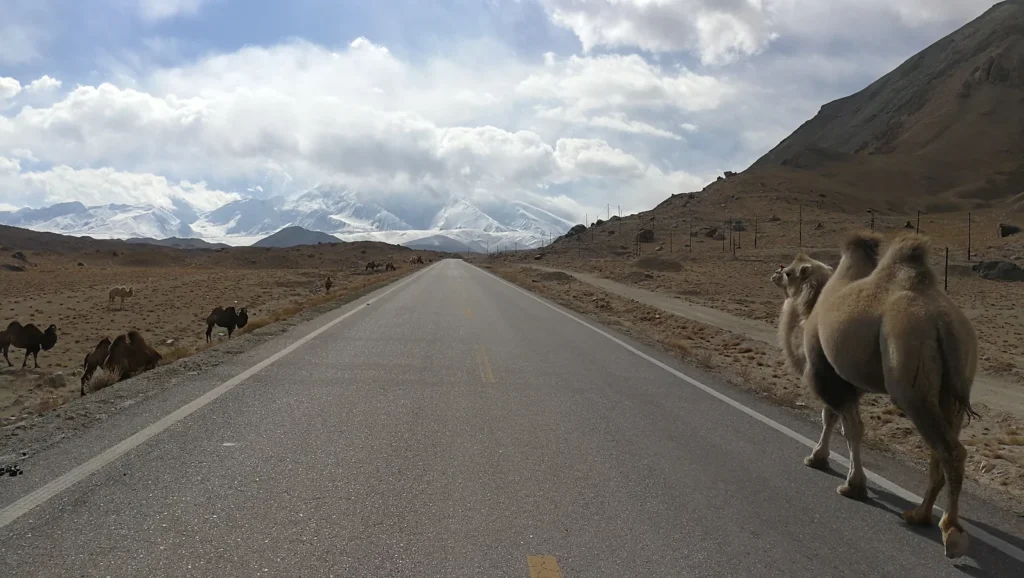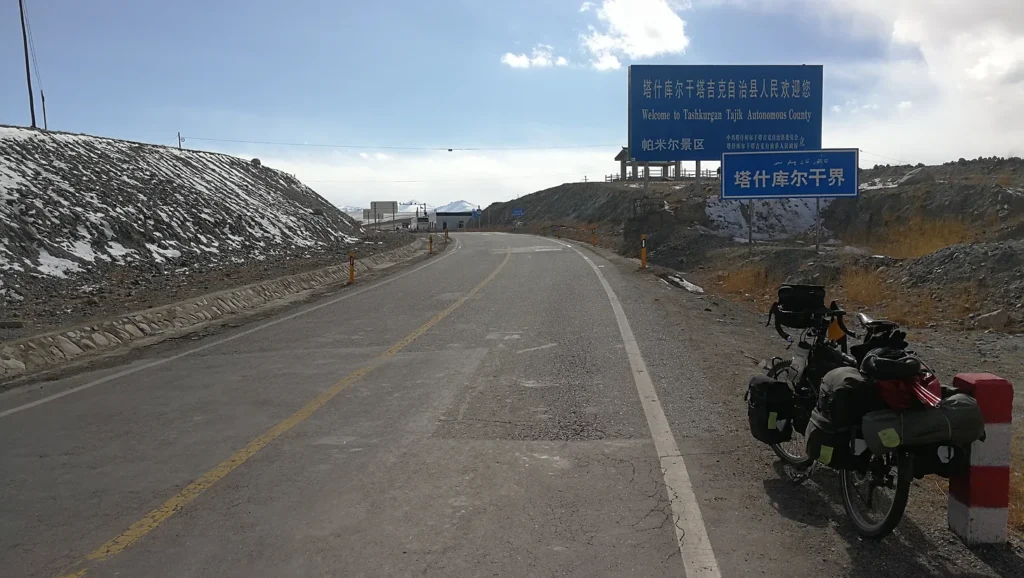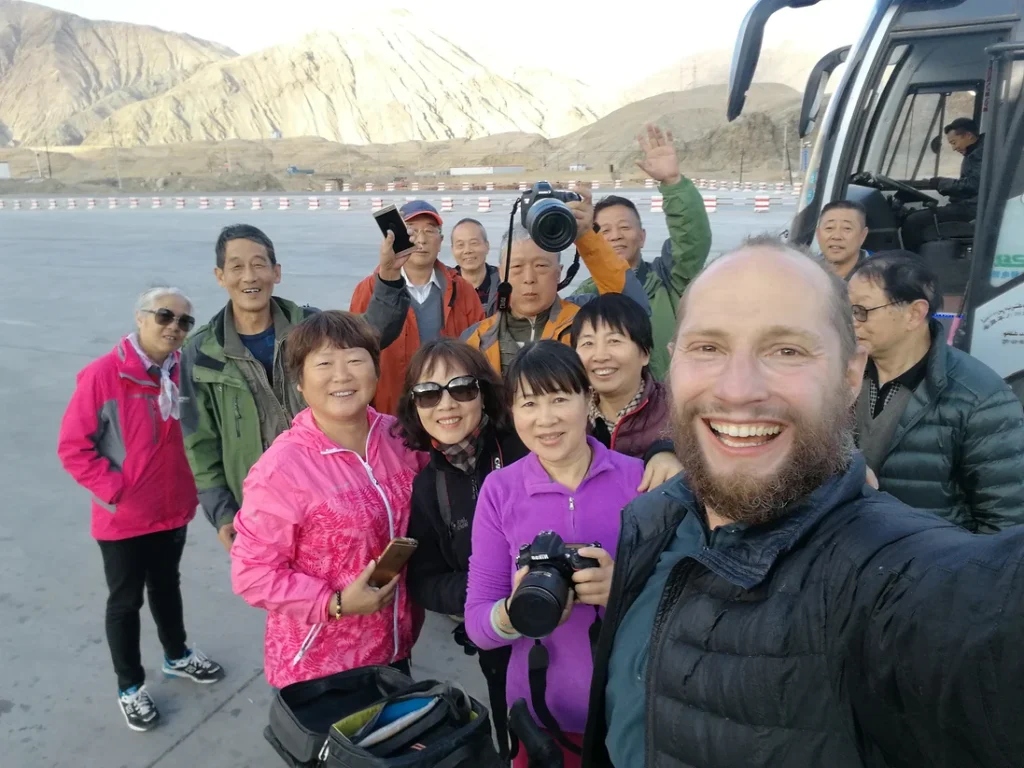China — Zen
After cycling past kilometers of standing trucks waiting for the border to reopen, I reached the Kyrgyz border checkpoint at 8am. Friendly and professional exit processing in 15 minutes.
The entry processing in China took 6.5 hours. At border checkpoint 1, all luggage was x-rayed (theoretically but the x-ray machine didn’t function) and the passports were checked, then I took a shared minivan to reach the inner border checkpoint.
110 kilometer from Kyrgyzstan at border checkpoint 2, we got off the van and walked through a building where our passports were checked again while the luggage remained in the van.
Another 30 kilometer later at border checkpoint 3, my equipment and bike was x-rayed and my passport and visa checked again – then I got my China entry stamp and formally entered the country.
Arriving in China felt special – I have deep respect for the Chinese culture and the people living here.
Already 2500 years ago, Chinese philosophers like Confucius, Sun Tzu and the mythical Laozi shaped the unfolding of the world with their clarity of thinking – parallel to Aristotle, Socrates, and Plato, they equally stressed the importance of self-reflection and acting based on knowledge of oneself.
Our consciousness exploration today builds on the shoulders of them all, the thinkers of the east and west alike – introspection has always been considered of timeless value.
Reaching Kashgar was a bit far for the first day so in the evening I got water from a stream and pitched camp under a road.
The core of what many people understand by Zen (meaning “meditation”) probably originated in India. According to legend, Zen ideas developed for hundreds of years until around the year 500 the monk Bodhidharma brought them to China under the name “Chan” from where later the ideas spread to Japan and beyond.
And according to legend, Bodhidharma came from Western regions to China so who knows, perhaps he came along here?
Dear reader, what is your name?
Say it out loud and listen to it for a moment … feel how the sound vibrates in your chest when you say your name, and listen into the silence after the sound waves have ebbed away.
That’s what is important – yourself. Your individual pain is important – we all experience it as part of our human condition and it’s ok.
Your curiosity and growth are important – we all are consciousness explorers driven forward by the same force, and we all constantly grow stronger on our self-discovery with every experience we make.
Your freedom and courage are important – whatever experiences life serves us, we all are free inside and we can always cultivate the courage to change our reality through the consciousness attention we choose.
Your healing and strength are important – I’m convinced that everyone can grow into a more authentic and braver and more forgiving version of themselves by practicing simple things in daily life like giving compassion to ourselves and the world.
The constant dialogue we all have inside, this cognitive debate about “who we are” and “what’s right and wrong” and “which values we stand for” and “how we live our life” – that’s all secondary.
What’s important is the real reality paraphrased by such words.
I’m just a guy on a bicycle and know almost nothing about Zen but I got that how we feel deep inside ourself is more important than world concepts on the surface.
“Knowledge in words and concepts” is a small part of our reality.
“True direct feeling” is a reality part that seems much larger.
Of course everything is linked and language has it’s place in the general existence of things. On our consciousness expedition, perhaps we benefit from sensing our ongoing “cognitive dialogue” more integrated with our feelings, breathing, and overall biological body. Lick your hand …
To me our ongoing inner meditation is something fascinating: no matter atheistic or spiritual world views, thinking about “Who am I?” and “How does reality function?” while sensing our innermost feelings makes life deep … and I also find it’s kind of fun.
I believe it’s worth going this way, to listen and feel more inside who we really are. Because when we listen into ourselves and when we give conscious attention to what’s arising, we create somethings valuable – authenticity.
Who are you really, dear reader?
What is your name again?
On the small roads parallel to the main highway there is almost no traffic and you see few people around.
Xinjiang is China’s largest province by area while having one of the lowest population densities. It’s basically the Western end of the Taklamakan desert so agriculture happens mainly along the few rivers in the area.
The seasons of the year, the journey of our life from birth to death – what are we making with all of that?
Living our life well given the experiences we make is an answer.
You may say ok but what does “a life lived well” exactly mean?
“Mean” – do you expect a linguistic answer?
Do you think that “meaning” in your life manifests through words and language and concepts, or through the way you directly feel?
You have to give the answer to yourself.
Here is some linguistic inspiration:
“Live your life so that the day you die you are proud of yourself.”
“Live your life as an active member of your community doing good.”
“Live your life maximizing your personal benefit as altruism is for the weak and it’s natural to conquer and suppress.”
“Live your life following the rules of human-made organizations such as a political party, the military, a fanatic religion, a marketing campaign, consumption patterns of others, and social media trends – happiness is in following the rules of others.”
Of the unlimited linguistic meanings that can be constructed using words – make your choice, and realize that you constantly already choose by living your life the way you exist.
And if meaning manifests in the way you directly feel?
Here words can only paraphrase the real thing (your true feelings) just like a geographic map is not the territory – but paraphrasing our feelings with words may still be helpful and healthy.
Here is some linguistic paraphrasing inspiration:
“Live your life so that you are feeling authentically yourself.”
“Life your life so that your feelings of courage and freedom grow no matter the experiences life is serving you – accept all feelings of pleasure and pain your consciousness holds.”
“Live your life so that tomorrow you love yourself and the world more than today.”
Of the unlimited feeling meanings that can be paraphrased using words – make your choice, and realize that you constantly already choose by living your life the way you exist.
Given that our cognition and ongoing inner dialogue are part of our reality anyways, and given that reality-paraphrasing words and concepts can be pointers into consciousness unfolding directions we like – which words should we be thinking while we exist?
I’m just a cyclist … I guess everybody answers this individually.
Perhaps sensing our body with our beating heart and breathing lung simultaneously with our feelings and word-based cognition is a consciousness attention state allowing us to find an answer.
In this state we can follow thoughts which have a positive resonance inside us – we can feel the language-reality connection with calmness and strength and clarity, and by doing so we bend reality in this very direction.
Do you think consciousness clarity helps us to live life well?
Do you think viewing your consciousness through the lens of a meditation approach like Zen (or any other lineage) can be helpful?
Are you aware that you can cultivate your own meditation approach wherever you are? Try the supermarket queue …
Breathing in, breathing out.
Kashgar old city has been an important hub for Silk Road travelers for over 2,000 years but in the last years it got completely demolished and rebuild.
Time to find a hostel and explore this city further – as a traveler I came not to judge but to expand my horizon.
I stayed three days in a downtown hostel with mainly Chinese travelers.
The city feels like some aspects of some parts of its 2,000-year history are remembered.
New cultural influences can be seen.
Traditional food can be found.
And Kashgar’s history and culture are explained on signs.
Did Mao Zedong act based on self-reflection and true knowledge of himself?
After the fall of the Qing Dynasty (which ruled for almost 3 centuries) and difficult years for China during the world wars, Mao founded the People’s Republic of China in 1949. And as the founding father of the nation it’s human that people remember him.
But what about Mao’s brutal oppression, systematic disinformation, and mass killing of millions of inhabitants of China?
The Chinese must decide for themselves how they deal with their history – I’m sure they are intelligent and educated enough to have a balanced debate. What’s surprising to me is this extreme ratio: the man who killed the most people in history (more than Hitler and Stalin) is still displayed central in society.
Mao is also on the front all six Renminbi bank notes of the current bank note series.
I used the time in Kashgar to repair some equipment.
And went to a food market on the last evening.
What I found astonishing in Kashgar was how unhappy everybody seemed to be. Everyone seemed to be focused on being functional, but I didn’t see any person in Kashgar smile.
I started early leaving Kashgar southbound – time to cross the Himalayas.
Is next to the road a good place to dry agricultural products? But then again there is almost no traffic so perhaps it doesn’t matter.
80 kilometers south of Kashgar the mountains began – first white then red.
In the evening I pitched camp in a canyon where I also found water to filter.
So what do you think about the role of consciousness clarity to live life well?
In my view it depends, or at least I would say consciousness clarity is just one ingredient to live life well.
One the one side, consciousness clarity and meditation can lead to something cold. I read stories of monks being advised by monastery fathers to stop doing formal meditation and to be more involved in social activities – when our meditation and the way we live our life are overly self-focused and ascetic, we may miss a sufficiently “heart-based” element inside us based on true human connection. In this situation, we may feel that despite great consciousness clarity we are missing something essential.
On the other side, consciousness clarity and meditation can lead to something warm. When I look at videos of (for example) Thích Nhất Hạnh or the Dalai Lama, I find most inspiring their high degree of true compassion for all beings as the base for their heart-based teachings. You can see that they have much more inside than consciousness clarity.
Within Zen as an example of a meditation approach, there are several traditions. They differ in things like the degree with which one is “actively seeking” something – more in Rinzai Zen which works more with paradoxical questions to help practitioners break free of concept-based thinking, less in Soto Zen which aims more to overcome mental concepts by stopping to seek anything at all.
Is there a goal in Zen?
It depends whom you ask. In my opinion, also regarding meditation goals a middle way is healthier than an extreme. Humans are probably too diverse to generalize here anyways and I also believe that people go through different life phases in which different consciousness attention directions and meditation goals serve them best.
“Serve them best” for what?
Feeling authentically themselves, feeling truly good, facing hardship with a positive attitude, making the best of every situation, living their life well by their own definition – things like that.
The way I perceive our human condition is that everyone of us is meditating all the time – by the existential act of having (or being?) a consciousness attention stream, we constantly perceive and shape our feelings, body, thoughts, actions, and overall life path embedded in a reality we co-shape.
“Monks” and “yogis” and “Zen meditators” practice their meditation more formally than most people, but from a general consciousness perspective I believe we all constantly meditate and use our attention force inside – whether we are aware of it or not.
I think that even when somebody wants to know nothing about self-reflection in life, and never consciously reflects on his or her own thoughts and feelings, and always plays video-games while surfing on social media while eating nachos with cheese – also this human has a constant attention stream inside from birth to death, perhaps not in an aware consciousness space, but it’s always there under all distractions.
If formal meditation is beneficial for you in your current life phase is something only you can decide for yourself, dear reader – perhaps it’s not, perhaps it would create new cognitive hurdles for you, perhaps you would benefit more from being more social.
Overall, developing more consciousness clarity probably benefits many people in many situations as long as it’s something like a holistic consciousness clarity and not just cognition-focused clarity – what we truly feel in our consciousness is key.
In my view, using our reality-bending force more consciously doesn’t require complex language-based concepts to achieve clarity and inner balance. Our consciousness attention stream has a direction (What do we give our attention to?) and something like an underlying emotional flavor (With which attitude do we give our attention?) – the rest is detail.
A noise outside my tent brought me back from inner traveling to the here in now – a group of donkeys passing through the canyon by themselves had stopped to inspect my tent.
Time to leave the canyon – the next 140 kilometer were uphill up to 4,100 meter elevation so I started cycling early.
I followed the Gaizi river valley southbound – almost no traffic or human settlements around.
The few other road users were relaxed.

I get it, it’s your road and I respect that.
This section of the Karakoram highway looked pretty new and mostly unused.
The mountain massif ahead has several 7,000 meter peaks towered by Kongur Tagh (7,719 meter).
The Karakoram highway was built by China and Pakistan 1962-1978 in challenging conditions costing around 900 workers their lives.
The donkeys, the camels, the sheep – all livestock I saw in these mountains moved around on their own without a shepherd.
I pitched camp early in the afternoon as I didn’t want to sleep too high to give my body more altitude acclimatization time.
If consciousness clarity helps us to use our reality-bending force more consciously – how do we develop it?
Having a motivation to develop it probably helps.
Consciousness clarity benefits both the smallest everyday questions in our life and our largest questions about the general existence of things – knowing who we are makes us strong.
And when we practice holistic consciousness clarity, our “knowing who we are” develops balanced. Yes, our cognitive stories and world concepts become clearer, but more importantly we sense and experience our natural everyday feelings betters … we become authentic – the central prerequisite to truly feel good.
Having trust in oneself probably helps too.
You can develop more consciousness clarity for sure – it’s easy and everybody can do it. And yes, you can practice consciousness clarity in your daily life wherever you are and whatever you do.
Remember your importance for others as you constantly co-create the world through the way you use your reality-bending force – it’s not just your world you are creating … you also create the world of all others.
Let’s assume for a moment that you decide to develop more consciousness clarity enabling you to use your reality-bending force more targeted …
Where do you start?
There is just one place you can start – where you already are.
Stories about Zen monks and yogis and cyclists are about their life – what counts is your life today, dear reader.
You can always close your eyes and observe your breath and your feelings to be in the right place for yourself to practice consciousness clarity.
Developing consciousness clarity is not a competition and with some practice it becomes easy – you can’t do it wrong.
Your values, your feelings, your previous life experiences, your plans for the future … that’s all ok, just calmly sense what you already have inside yourself.
What are you thinking and feeling about your life today?
Are you aware of your force to bend reality?
Baisha lake is a large artificial reservoir. I’m not sure if it was created for electricity production, at least I didn’t see turbines at the damn. Perhaps it was created to improve downstream flood management?
South of Baisha lake the Karakoram highway winds through a broad glacial valley – nobody around.
I was surprised to find a tea and noodles restaurant in the middle of nowhere – I happily stopped for a break as in the cold I need more calories to cycle.
The road followed a large half-circle around Muztagh Ata (7,546 meter) – I felt strong but the wind was a challenge.
At the pass (4,100 meter) is a police checkpoint.
I had just my passport checked and was allowed to continue.
Great downhill racing from cold to less cold. Before the pass the headwind had been so strong that I thought I would need an additional day to reach Tashgurkan but now the city was within reach by this evening.
West of Muztagh Ata I passed another checkpoint which is also the entry checkpoint when you come to China via Qolma pass from Murghab in Tajikistan.
The last 20 kilometers before Tashgurkan the road crosses a large plateau.
At the beginning of Taskgurkan I passed another checkpoint – good opportunity to say hello to people.
Tashgurkan lies close to the quadruple border point between Tajikistan, China, Afghanistan, and Pakistan. It’s a small city stretched out along a river and has been a Silk Road traveler hub for over 2,000 years.
It felt good to reach the last town in China – cycling Kashgar to Tashgurkan in three days had been great mountain cycling and now I was excited to enter Pakistan tomorrow.
Five minutes after I had checked into a hotel, the police arrived and informed me that the border area was being cleared of all travelers (foreigners and Chinese tourists) and that I have to go back to Kashgar tomorrow morning. The reason given was that the National Congress of the Chinese Communist Party in Beijing (which happens every five years) will start in two days … apparently it’s a Chinese custom to close down the country during such events.
I pointed out that I showed my passport at five police checkpoints since Kashgar and every time I was told it’s fine to continue. I also pointed out that if I cross the border tomorrow I would be faster out of China than back in Kashgar – but the new policy decision was unshakable.
Sometimes in life, all you can do is accept and learn.
The next morning I took a shared van back to Kashgar where I learned that the border will be closed for two weeks – luckily I had enough visa days left to just sit it out. This time I went to another hostel where I met a couple of other cyclists in the same situation.
The importance of free thinking and doing the right thing based on individual self-reflection has been pointed out by Chinese philosophers like Confucius and Laozi already 2,500 years ago – a cultural heritage the Chinese people can be proud of.
Of course individuals may experience traumas which can spin out of control when not being healed: would Mao Zedong have slaughtered a couple of million Chinese citizens less if he had done a therapy to process the brutality he experienced in his childhood?
Perhaps Mao just didn’t have someone who loved him unconditionally, someone who was there to listen when he needed to feel and express and heal his pain.
I used the waiting time to learn some Urdu for Pakistan which will also be useful in India as spoken Hindi is pretty similar.
While waiting for the border to reopen I met a powerful Chinese dragon – he told me to really find truth, we must look inside ourself.
In some years Khunjerab pass (4,693 meter) closes in early November for half a year due to snowfall – it’s the only China-Pakistan border crossing so it was nice that it finally reopened.
Tashgurkan – let’s try this again.
Icy morning, long border formalities … but we finally organized everything and figured out where to go.
After having our passports checked and equipment x-rayed, we cycled to a second border station two kilometers away where the procedure was repeated. When all was done, a Pakistani bus picked us up.
China, thank you for the impulses on Zen – I have deep respect for the rich Chinese cultural heritage and the people living here.































































